|
|
|
|
|
Oil On
Canvas, Real Flavor of Old Masters
|
|

|
ARTWORKS
INDEX
A B C D E F G H I J K L M N O P Q R S T U V W X Y Z |
ARTISTS
INDEX
A B C D E F G H I J K L M N O P Q R S T U V W X Y Z |
|
|
| | |
|
|
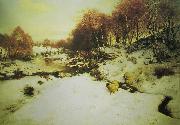 |
Joseph Farquharson -- Click Here
|
|
Joseph Farquharson DL (4 May 1846 - 15 April 1935) was a Scottish painter, chiefly of landscapes. He is most famous for his snowy winter landscapes, often featuring sheep and often depicting dawn or dusk. He was born in Edinburgh, Scotland and died at Finzean, Aberdeenshire, Scotland.
Joseph Farquharson combined a long and prolific career as a painter with his inherited role as a Scottish laird. He painted in both oils and water colours. His mother, a celebrated beauty, was an Ainslie. His early days were spent in his father's house in Northumberland Street below Queen Street Gardens and later at Eaton Terrace beyond the Dean Bridge, Edinburgh and at Finzean, the family estate in the highlands.[1] His father Francis was a doctor and laird of Finzean. Joseph was educated in Edinburgh and permitted by his father to paint only on Saturdays using his father's paint box. When Joseph reached the age of 12, Francis Farquharson bought his son his first paints and only a year later he exhibited his first painting at the Royal Scottish Academy. |
|
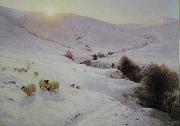 |
Joseph Farqharson -- Click Here
|
|
painted The Sun Peeped o'er yon Southland Hills
Joseph Farquharson DL (4 May 1846 -15 April 1935) was a Scottish painter, chiefly of landscapes. He is most famous for his snowy winter landscapes, often featuring sheep and often depicting dawn or dusk. He was born in Edinburgh, Scotland and died at Finzean, Aberdeenshire, Scotland. |
|
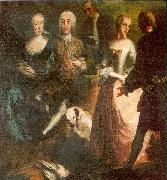 |
Joseph Esperlin -- Click Here
|
|
painted Engagement of Maria Josepha Grafin von Waldburg-Friedberg-Scheer (1731 - 1782) and her cousin, Prince Joseph Wenzel von Furstenberg (1728 - 1783) in 1748 |
|
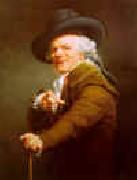 |
Joseph Ducreux -- Click Here
|
|
1735-1802
French
French painter, pastellist and engraver. He lived in Paris from 1760 and from 1762 kept a list of his works. Among the portraits he completed in his early years were those in pastel of the well-known connoisseurs Pierre-Jean Mariette, the Comte de Caylus and Ange-Laurent de la Live de July (all untraced), which apparently were copies after Maurice-Quentin de La Tour. Ducreux has traditionally been seen as de La Tour favourite pupil, while Jean-Baptiste Greuze is supposed to have initiated him into oil painting. From his age, it can be assumed that by the time Ducreux reached Paris he had already acquired a grounding in his art. |
|
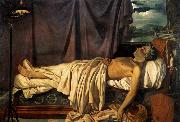 |
Joseph Denis Odevaere -- Click Here
|
|
1778-1830,Flemish painter. He attended evening classes at the Bruges Academie in 1794-5 and then went to Paris, where he entered the studio of the Bruges artist Joseph-Benoet Suvee. In 1801 he began training under Jacques-Louis David and in 1804 won the Prix de Rome for his Death of Phocion (Paris, Ecole N. Sup. B.-A.), in which he faithfully adhered to the principles of David's teaching. Before going to Italy he spent a year in Bruges carrying out portrait commissions, including the Marquis de Chauvelin (1805; Bruges, Groeningemus.). During his time in Rome (1805-12) he copied antique and Renaissance works, taking a particular interest in Raphael, who features in his wash drawing the Master of Urbino Introduced by Bramante to Julius II (1807; Bruges, Groeningemus.), a study for a lost painting. Around 1811 he was among the artists chosen to decorate the Palazzo del Quirinale for Napoleon's visit, although he never executed more than a sketch, Tanaquil Predicting the Future Greatness of Servius Tullius (c. 1811-12; Dijon, Mus. Magnin). Odevaere successfully exhibited in Paris in 1812 and then moved to Ghent, showing works at the Salon there two years later. After the union of the Low Countries in 1815 he became official painter to William I. As a result of this post he executed several works illustrating the history of the Dutch royal family, including the Prince of Orange Wounded at Waterloo (1817) and the Battle of Nieuwpoort (1820; both Brussels, Pal. Nation, on dep. Brussels, Pal. Justice). In 1815 he was commissioned to recover works of art taken from the Low Countries by the French. David's arrival in Brussels in 1816 coincided with the beginning of Odevaere's most ambitious composition, the Departure of the Athenians for Salamis (1816-25; Brussels, Mus. A. Anc.), inspired as much by Jean-Auguste-Dominique Ingres as by David, although the latter frequently advised Odevaere on the painting. From 1825 to 1829 he worked on a series of paintings conveying his support of the philhellenic committees created during the Greek War of Independence. |
|
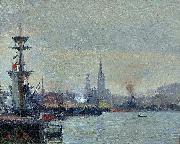 |
Joseph Delattre -- Click Here
|
|
painted Le Port de Rouen in 19th century
|
|
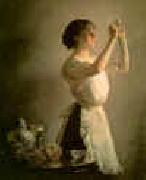 |
Joseph Decamp -- Click Here
|
|
1858-1923
Joseph Rodefer DeCamp (November 5, 1858 - February 11, 1923) was an American painter.
Born in Cincinnati, Ohio, he studied with Frank Duveneck in that city. In the second half of the 1870s he went with Duveneck and fellow students to the Royal Academy of Munich, then spent time in Florence, Italy, returning to Boston in 1883.
He became known as a member of the Boston school led by Edmund Charles Tarbell and Emil Otto Grundmann, focusing on figure painting, and in the 1890s adopting the style of Tonalism. He was a founder of the Ten American Painters, a group of American Impressionists, in 1897.
A 1904 fire in his Boston studio destroyed several hundred of his early paintings, including nearly all of his landscapes.
He died in Boca Grande, Florida. |
|
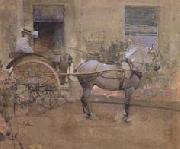 |
Joseph Crawhall -- Click Here
|
|
1861-1913
English painter, active in Scotland. He was brought up in Newcastle upon Tyne and was encouraged by his father and by Charles Keene, the cartoonist for Punch, studying at King's College School in London under P. H. Delamotte. There he met E. A. Walton, with whom, joined by James Guthrie, he painted at Roseneath, near Glasgow, in 1879. Crawhall also collaborated with Walton and Guthrie on illustration. His association with the Glasgow Boys was consolidated during the early 1880s on further painting trips in the Trossachs, Berwicks, and Crowland, Lincs. A keen huntsman and rider, Crawhall specialized in bird, animal and humorous subjects, and his work, with that of Arthur Melville, exemplifies the achievement of the Glasgow Boys in watercolour. After studying in Paris in 1882 under Aim? Morot (1850-1913), Crawhall exhibited for the first and only time at the Royal Academy, probably showing A Lincolnshire Meadow (1883; Glasgow, A.G. & Mus.). He then virtually abandoned oil painting and the plein-air technique, working instead from memory and using line and watercolour. |
|
|
|
|
|
|
|
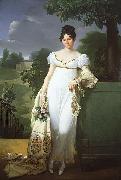 |
Joseph Blondel -- Click Here
|
|
Merry-Joseph Blondel (Paris, July 5, 1781 - Paris, June 12, 1853) was a French neo-classic painter.
After a first training in the Dilh et Guerhard porcelain factory, he later was a painting student of Jean-Baptiste Regnault. He won in 1803 Price of Rome with his painting Enee portant son pere Anchise. He lived in Villa Medicis, in Rome, Italy, from 1809 to 1812, and won a gold award for his painting Mort de Louis XII. He then started a career as an interior decorator (Fontainebleau Castel, Brongniart Palace, Louvre Museum, Senat). |
|
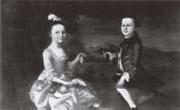 |
Joseph Blackburn -- Click Here
|
|
English-born American Rococo Era Painter, ca.1700-1780 |
|
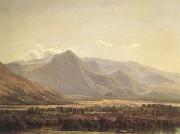 |
Joseph Bidauld -- Click Here
|
|
Carpentras(Vaucluse)1758-Montmorency (Val d'Oise)1846
French painter. He was apprenticed in Lyon for six years with his brother Jean-Pierre-Xavier Bidauld (1745-1813), a landscape and still-life painter. Subsequently, they left Lyon to travel together in Switzerland and Provence. In 1783 he moved to Paris, where he met Joseph Vernet (from whom he received valuable advice), Joseph-Siffred Duplessis and Jean-Honor? Fragonard. In 1785 he went to Rome with the assistance of Cardinal de Bernis and his patron, the dealer and perfumer Dulac. He stayed there for five years, travelling through Tuscany, Umbria and Campania and painting such works as Roman Landscape (1788; Basle, Kstmus.). Bidauld was closely involved with the circle of French Neo-classical painters in Rome in the 1780s. He was friendly with Louis Gauffier, Nicolas-Antoine Taunay and especially with Guillaume Lethiere, who became his brother-in-law and with whom he occasionally collaborated. On his return to Paris in 1790 he travelled extensively in France, |
|
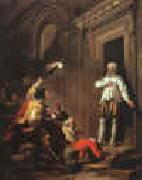 |
Joseph Benoit Suvee -- Click Here
|
|
1747-1807
French
Joseph Benoit Suvee Gallery |
|
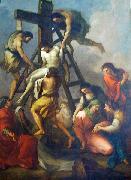 |
Joseph Barney -- Click Here
|
|
(1753 - 13 April 1832), was an English artist and engraver. He is usually described as a pupil of Antonio Zucchi and Angelica Kauffmann and as a fruit and flower painter to the Prince Regent. He was born in Wolverhampton.
Two of his large-scale paintings - altar pieces eThe Deposition from the Crosse (1781) and eThe Apparition of Our Lord to St Thomase (1784) have been preserved in Wolverhampton, and can be seen today at St Johnes church and at St Peter & St Paules Roman Catholic church. During Barneyes life-time, his artistic achievements were respected and praised. In 1798, Stebbing Shaw, mentioning eThe Deposition from the Crosse in his eHistory of Staffordshiree called Barney a enative geniuse of Wolverhampton. In the collection of Wolverhampton Art Gallery, there is a pen and ink drawing, eA Blind Musiciane, which gives some additional idea of quality and versatility of Barneyes works.
|
|
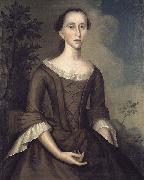 |
Joseph Badger -- Click Here
|
|
(ca.1707-1765) was a portrait artist in Boston, Massachusetts in the 18th-century. He painted some 80 portraits of merchants, businessmen, clergy, and other notables, and their wives and children.
Badger was born in Charlestown, Massachusetts, to tailor Stephen Badger and Mercy Kettell. In 1731 he married Katharine Felch; they moved to Boston around 1733. He was a member of the Brattle Street Church.
He "began his career as a house-painter and glazier, and ... throughout his life continued this work, besides painting signs, hatchments and other heraldic devices, in order to eke out a livelihood when orders for portraits slackened."
|
|
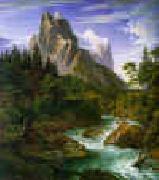 |
Joseph Anton Koch -- Click Here
|
|
1768-1839
Austrian
Joseph Anton Koch Galleries
was an Austrian painter of the German Romantic movement. The Tyrolese painter left academic training in the Karlsschule Stuttgart, a strict military academy, and traveled through France and Switzerland. He arrived in Rome in 1795. Koch was close to the painter Asmus Jacob Carstens and carried on Carstens' 'heroic' art, at first in a literal manner.
After 1800 Koch developed as a landscape painter. In Rome he espoused a new type of 'heroic' landscape, revising the classical compositions of Poussin and Lorrain with a more rugged, mountainous scenery. He left Rome in 1812 and stayed in Vienna until 1815, in protest of the French invasion. During this period he incorporated more non-classical themes in his work. In Vienna he was influenced by Friedrich Schlegel and enthusiasts of old German art. In response, his style became harsher, and this new approach had a wide influence on German landscape painters who visited Rome. |
|
|
|
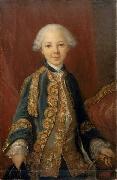 |
Joseph Albrier -- Click Here
|
|
(1791 -1863 ) - Painter
|
|
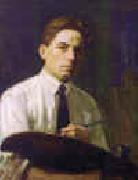 |
Joseph A Kleitsch -- Click Here
|
|
1885-1931
Joseph Kleitsch (1885-1931) was an American painter who holds a high place in the early California School of Impressionism. Born in Banad, Hungary on June 6th, 1885, young Joseph Kleitsch was drawn to paint at the early age of seven, he later pursued his professional art training at Budapest, Munich and Paris. Influenced by his visits to the famous museums of Europe, Kleitsch continued with his love of portrait and figuritive painting after relocating to California. There he rose to the challenge of capturing his new environment's brilliant light and diverse landscape. Living in Los Angeles for a while, Kleitsch fell in love with the rustic artist village of Laguna Beach. There he painted the town's eucalyptus lined streets, the crashing waves of the Pacific coastline and the nearby Mission San Juan Capistrano. Arthur Millier of the Los Angeles Times in 1922 was quoted saying of Kleitsch "he was a born colorist; he seemed to play on canvas with the abandon of a gypsy violinist". Joseph Kleitsch died at the age of forty-nine in Santa Ana, California on November 16th, 1931. |
|
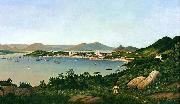 |
Josehp Bruggemann -- Click Here
|
|
painted Vista do Desterro in 1867 |
|
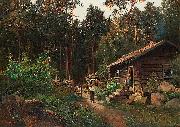 |
Josefina Holmlund -- Click Here
|
|
(1827 -1905 ) - Painter
|
|
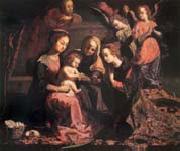 |
Josefa of Ayala -- Click Here
|
|
1630-1684,Portuguese painter and engraver. She was the daughter of the Portuguese painter Baltazar Gomes Figueira (1597-1674) and a Spanish lady, Doea Catarina de Ayala y Cabrera. After the restoration of the Portuguese monarchy in 1640 the family moved to Coimbra. Here Josefa began her apprenticeship under her father, a painter of landscapes, still-lifes and religious works, who in 1644 painted the retable of Nossa Senhora da Graea, Coimbra, in the naturalist-tenebrist style he had learnt in Seville in the circles of Juan del Castillo, |
|
|
|
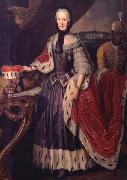 |
Josef Schmitz -- Click Here
|
|
Johann Josef Schmitz (1784-)Aliases: Johan Joseph SchmitzProfessions: Landscape painter. |
|
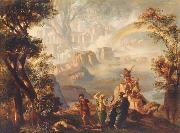 |
Josef Hoffmann -- Click Here
|
|
painted Outside the Hall of the Gibichungs in 1876 |
|
|
|
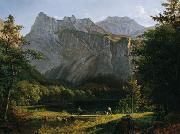 |
Josef Feid -- Click Here
|
|
Austria (1806-1870 ) - Painter |
|
|
|
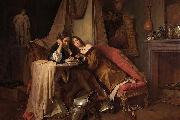 |
Josef Danhauser -- Click Here
|
|
Josef Danhauser (August 19, 1805, Laimgrube (now a part of Mariahilf or Neubau) - May 4, 1845) was an Austrian painter, one of the main artists of Biedermeier period, together with Ferdinand Georg Waldmeller, Peter Fendi, among others. His works, not very appreciated in his days, dealt with very moralising subjects and they had a clear influence of William Hogarth.
Joseph Danhauser was born in Vienna in 1805, the eldest son of sculptor and furniture manufacturer Joseph Ulrich Danhauser and his wife Johanna (nee Lambert).
He took his first painting lessons with his father and he later assisted the Vienna Academy of Fine Arts. He studied with Johann Peter Krafft and made his first exhibition 1826.
Invited by Johann Ladislaus Pyrker, patriarch of Venice, he visited the city of Doges, where he started to study the Italian masters. He came back to Vienna via Trieste in 1827, visiting Prague. That very year he painted Ludwig van Beethoven's death mask, roughly 12 hours after his death and a water-colour representing his deathbed. In 1828, he spent some time in Eger, with an invitation of this Hungarian city archbishop Pyrker. He solicited him for some pictures for the gallery of the Archdiocese.
After his father's death in 1829, his brothers and he managed his furniture factory during the Biedermeier movement, being the precursors of modern design. That made him put his painting career aside.
In 1833, he responded to a second invitation from Eger's archbishop and he painted The martyr of Saint John for a new basilica in the city and he received the Vienna Academy prize for his picture Die Verstobung der Hagar and he specialised in Genre works. In 1838, he was appointed vice-rector of the Academy and married Josephine Streit, who was the daughter of a physician and with whom he had three children, Josef, Marie and Julie, born in 1839, 1841 and 1843 respectively.
Josef Danhauser was appointed professor of historical Painting at the Academy in 1841, but he left this occupation and he travelled around Germany and the Netherlands with the textile maker, art aficionado and art sponsor Rudolf von Arthaber. In this journey, he was very interested in the Dutch School and the format of his works was littler. He died of typhus in Vienna in 1845. They named a street with his name in Vienna in 1862. |
|
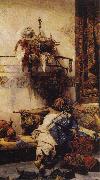 |
Jose Villegas y Cordero -- Click Here
|
|
Spanish, 1848 - 1921 |
|
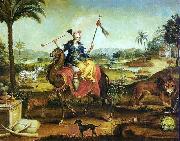 |
Jose Teofilo de Jesus -- Click Here
|
|
painted asia in 1758-1847 |
|
|
|
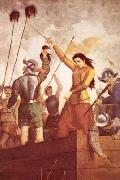 |
Jose Mercedes Ortega -- Click Here
|
|
painted Dona Ines de Suarez in defending the city of Santiago in 1897 |
|
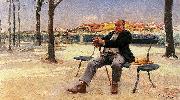 |
Jose Malhoa -- Click Here
|
|
(Caldas da Rainha, 28 April 1855 ; Figueire dos Vinhos, 26 October 1933) was a Portuguese painter.
Malhoa was, with Columbano Bordalo Pinheiro, the leading name in Portuguese naturalist painting, in the second half of the 19th century. He painted often popular scenes and subjects, like his two most famous paintings, "The Drunks" (1907) and "Fado" (1910). He always remained faithful to the naturalist style, but in some of is works, there are impressionist influences, like in his "Autumn" (1918), that can be considered as an "impressionist exercise".
He saw at the end of his life, the inauguration of the Jose Malhoa Museum, in Caldas da Rainha.
|
|
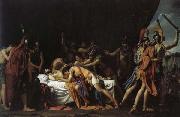 |
jose Madrazo Y Agudo -- Click Here
|
|
Spanish Neoclassical Painter, 1781-1859
was a Spanish painter of the Neoclassic period. Born in Santander. Studied in Madrid with Cosme de Acuna and Gregorio Ferro, both rectors of the Academia de San Fernando at the beginning of the 19th century. Don Fernando La Serna, who was named ambassador to France at the time, brought Madrazo to Paris, where he entered the studio of Jacques-Louis David. There, under royal patronage from King Carlos IV, he executed a painting of the Death of Lucretia and other canvases on events from classic Greco-Roman history. He moved to Rome during Napoleonic times, where he was briefly jailed for failing to complete oaths of loyalty to the newly installed Napoleon II of France as King of Rome. In Rome, he was admitted to the Accademia di San Luca. King Carlos IV named him pintor de camara (painter of the chamber), a position confirmed by King Ferdinand VII. |
|
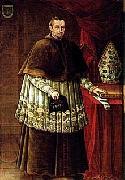 |
Jose Legarda -- Click Here
|
|
painted Portrait of Manuel de Alday, bishop of Santiago de Chile in 1772 |
|
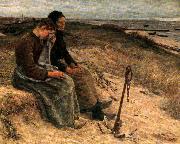 |
Jose Julio Sousa Pinto -- Click Here
|
|
painted Barco desaparecido in 1890 |
|
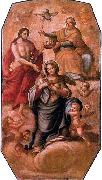 |
Jose Joaquim da Rocha -- Click Here
|
|
painted Coronation of Our Lady in 1790 |
|
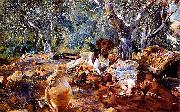 |
Jose Jimenez Aranda -- Click Here
|
|
(February 7, 1837 - May 6, 1903) was a Spanish painter.
Persondata
Name Jimenez Aranda, Jose
Alternative names
Short description
Date of birth February 7, 1837
Place of birth
Date of death May 6, 1903
Place of death
|
|
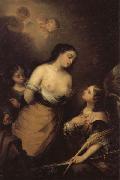 |
Jose Gutierrez De La Vega -- Click Here
|
|
Spanish , 1791-1865
|
|
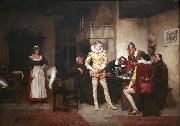 |
Jose Frappa -- Click Here
|
|
painted Lamb amongst wolves in 1882 |
|
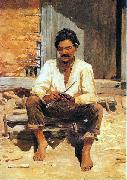 |
Jose Ferraz de Almeida Junior -- Click Here
|
|
(8 May 1850 - 13 November 1899) was a Brazilian painter of the 19th century. He is widely regarded as the most important Brazilian realist painter of the 19th century, and a major inspiration for the modernist painters. While most Brazilian academic artists made their fame painting mythological or historical subjects, Almeida Junior would become popular for painting rural figures, especially farmers and the caipira violeiro , the countrymen that are a kind of a symbol of the rural areas of the São Paulo state.
While most realist painters used farmers and countrymen as an allegory of workers, Almeida Junior would paint his caipiras mostly on leisure time. He would also produce touching images of upscale landowners. The Bandeirantes, the ruthless explorers of colonial Brazil, would be depicted in the A partida da monção, showing an expedition on the Tiete River.
Almeida Junior was born in the city of Itu, then a small town in the state of São Paulo. After becoming a sensation in his town he would be invited to study in the Brazilian Imperial Fine Arts Academy of Rio de Janeiro, but in 1876 would study in France after being granted a scholarship by emperor Pedro II of Brazil in person in the city of Moji-Mirim. He would have Alexandre Cabanel as one of his masters. In 1877 he was already enrolled in the School of Fine Arts in Paris. He took part at the Salon de Paris with several works of art in 1879 (Retrato do Dr. Jose de Magalhães), 1880 (O Derrubador Brasileiro) and (Remorso de Judas), 1881 (Fuga para o Egito) and 1882 (Descanso do Modelo) He admired the French realist and naturalist painting (a major influence at his work), and, after returning to Brazil in 1882, became of the leading names in Brazilian realist painting.
He was stabbed to death by the husband of his mistress on November 13, 1899 in Piracicaba.
|
|
 |
Jose de Ribera -- Click Here
|
|
Spanish Painter and Print engraver , 1591-1652
Information concerning the life and personality of Jusepe de Ribera is sparse. He was born the son of a shoemaker in Jetiva, Valencia Province. He appears to have gone to the city of Valencia while still a boy, but nothing is known of his possible artistic training there. As an adolescent, he traveled to Italy and spent time in Lombardy. Next he was in Parma, from which, it is said, he was driven by the contentious jealousy of local artists. He located himself in Rome until an accumulation of debts forced him to flee. Finally he settled in Naples, where in 1616 he married Caterina Azzolino, the daughter of a painter, by whom he had seven children between the years 1627 and 1636. The Academy of St. Luke in Rome elected Ribera to membership in 1625, and 6 years later the Pope conferred upon him the Order of Christ. It is understandably speculated that Ribera revisited Rome for these events. Being sought after in Naples by the Church and the various Spanish viceroys who ruled there in the name of the Spanish monarchy, he dismissed the idea of returning to his homeland. He was quoted as saying that he was honored and well paid in Naples and that Spain was a cruel stepmother to its own children and a compassionate mother to foreigners. Nevertheless, he generally added his nationality when he signed his works. This practice inspired the Italians to nickname him "the Little Spaniard" (Lo Spagnoletto). The last decade of Ribera's life was one of personal struggle. He suffered from failing health, the taunts of other artists that his fame was "extinct," and difficulty in collecting payments due him. Nevertheless, he kept it from being a tragic defeat by continuing to paint until the very year of his death in Naples. Actually, he was the victim of the local politics and finances. Naples was in the throes of a severe economic depression for which the foreign rulers, the patrons of Ribera, were naturally blamed, and the desperate citizenry was rioting in the streets. It is significant that Ribera continued to receive commissions in such a time, even if there was a dearth of payments. Ribera was inventive in subject matter, ranging through visionary spectacles, biblical themes, genre, portraits, mythological subjects, and portraits of ascetics and penitents. |
|
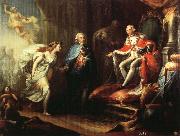 |
Jose Aparicio Inglada -- Click Here
|
|
1770-1838 Spain. b Alicante, 1770; d Madrid, 1838 |
|
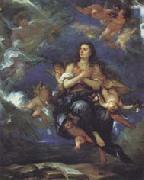 |
Jose Antolinez -- Click Here
|
|
Spanish Baroque Era Painter, 1635-1675
was a Spanish painter of the Baroque period. Antolinez's early training as a landscape artist may have been under Iriarte. Later, when he moved to the court in Madrid, he entered the studio of Francisco Rizi. His '"haughty character and sarcastic personality gained him many enemies among his contemporaries". Some note he played maddening jokes on his colleagues Claudio Coello and Cabezalero as well as Itizi, whom he called painter of wall ornaments, in allusion to the latter's decoration of the hall of comedies in the Palace of Buen Retiro |
|
 |
Jose del Castillo -- Click Here
|
|
1737-1793
Spanish
Jose del Castillo Location
a Spanish painter and a leader of the artistic movement Illustrious Absolutism. Many of his paintings were done on tapestries.
Castillo made many attempts to become Royal Painter for the Spanish monarchy, but he was never successful. This was not due to a lack of talent, but rather because Castillo allied himself with the wrong noble. His patron, the Earl of Floridablanca, feuded bitterly with the Earl of Aranda. The Earl of Aranda was favored by King Carlos III, and as a result, Ram??n Bayeu (Aranda favorite painter) became Royal Painter.
After Carlos III died, Castillo tried again to become Royal Painter. Unfortunately, the new monarch, Carlos IV, decided to leave the position of Royal Painter vacant.
|
|
|
|
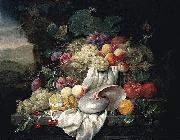 |
Joris van Son -- Click Here
|
|
1623-1667) was a highly popular Flemish Baroque painter of fruit and flowers, in banquet style on a plank, but also in garland form.
He seems to have been influenced by Jan Davidszoon de Heem, since his subjects follow his style quite closely. According to Houbraken his paintings were prized for preserving summer plenty in the middle of winter. In a poem by Cornelis de Bie, it is written that his fruits would tempt a pregnant woman. His paintings hang in many european museums, and the Dutch RKD has over 70 known works by him on record. He signed his works JORIS VAN SON. His students were Frans van Everbroeck, Jan Pauwel Gillemans II, and Norbert Montalie. |
|
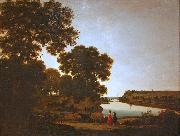 |
Joris van der Haagen -- Click Here
|
|
(ca. 1615 - The Hague, 23 May 1669 (buried)) was a Dutch Golden Age painter specialized in landscapes.
Contents
It is unclear where Joris van der Haagen was born, either in Arnhem or Dordrecht, but archival evidence shows that he started his drawing career in Arnhem. He probably learned to paint from his father, the painter Abraham van der Haagen. When his father died he moved in 1639 to the Hague, where he joined the Guild of St. Luke in 1643. A year later he became honorary citizen of The Hague. In 1656 he was one of the founding members of the Confrerie Pictura, which was located on the Princessegracht in the Hague. The painting he made of the Princessegracht at this time probably shows the original building, which has since been renovated beyond recognition.
|
|
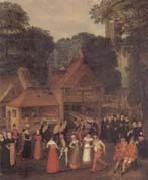 |
joris Hoefnagel -- Click Here
|
|
Flemish Northern Renaissance Manuscript Illuminator, 1542-ca.1600,Flemish illuminator and draughtsman. He was the last of the great Flemish manuscript illuminators and the foremost topographical draughtsman of his age. His work forms a critical link between earlier manuscript illumination and ornamental design and the genre of floral still-life painting, |
|
 |
Jorg Ratgeb -- Click Here
|
|
German Northern Renaissance Painter, ca.1480-1526 |
|
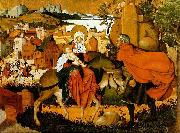 |
Jorg Breu the Elder -- Click Here
|
|
(c. 1475 -- 1537), of Augsburg, was a painter of the German Danube school. He was the son of a weaver.
He journeyed to Austria and created several multi-panel altarpieces there in 1500-02, such as the Melk Altar (1502). He returned to Augsburg in 1502 where he became a master. He travelled to Italy twice, in ca. 1508 and in 1514/15.
After his death in 1537, his son, Jörg Breu the Younger continued to lead his Augsburg workshop until his own death 10 years later. |
|
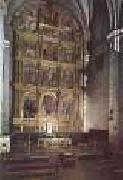 |
JORDAN, Esteban -- Click Here
|
|
Spanish painter/sculptor (1534-1600) |
|
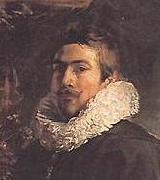 |
JORDAENS, Jacob -- Click Here
|
|
Flemish painter (b. 1593, Antwerpen, d. 1678, Antwerpen).
Flemish painter, tapestry designer and draughtsman. In the context of 17th-century Flemish art, he emerges as a somewhat complicated figure. His oeuvre, the fruit of a continual artistic development, is characterized by great stylistic versatility, to which the length of his career contributed. His religious, mythological and historical representations evolved from the rhetorical prolixity of the Baroque into a vernacular, sometimes almost caricatural, formal idiom. The lack of idealistic treatment in his work is undoubtedly the factor that most removed Jordaens's art from that of his great Flemish contemporaries Rubens and van Dyck. Jordaens's officially commissioned works included many paintings in which the sublimity of the subject-matter clashed with the vulgarity of some of his figures. Unlike Rubens and van Dyck, both of whom were knighted in the course of their careers, Jordaens was, in fact, completely ignored by the courts of Spain and Brussels |
|
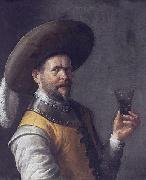 |
Joost Cornelisz Droochsloot -- Click Here
|
|
(1586, Utrecht (city) - May 14, 1666, Utrecht (city)), was a Dutch Golden Age painter.
According to Houbraken his village scenes (Boerekermisstuk) were as popular as flower pieces by Bartholomeus Assteyn.Houbraken thought he was born in Gorinchem or Dordrecht, and claimed he worked for a long time in Dordrecht. He felt his work was always according to a set pattern, where cake sellers were portrayed in front of village houses with figures in a festive setting called a "farmer's circus". It is unclear why Houbraken would have thought he was from Dordrecht, especially since Houbraken's data on painters from Dordrecht was generally quite accurate. Droochsloot and his son were highly respected citizens of Utrecht with a large workshop.
According to the RKD his monogram was "JCODS" and he became a member of the Utrecht Guild of Saint Luke in 1616. He later became deacon of the guild in 1623 and regent of the St. Jobs Gasthuis in 1638, deacon of the Dutch Reformed church, and in 1665 officer of the Utrecht schutterij. He was the father of the painter Cornelis Droochsloot (1630-1673) whose paintings are hard to distinguish from his own, and the teacher of Jacob Duck. |
|
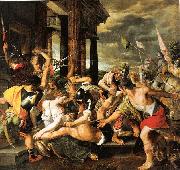 |
Joos van Winghe -- Click Here
|
|
(1544, Brussels - 1603, Frankfurt), was a Flemish Renaissance painter.
According to Karel van Mander he was born in Brussels in 1544 and travelled to Rome where he lived with a Cardinal for four years. When he returned to Brussels he became court painter to the Prince of Parma until he left the country in 1584 as a consequence of the Fall of Antwerp. He settled in Frankfurt and his place at Parma's court was taken by Otto van Veen. He died in 1603, aged 61. Van Mander mentions several pieces by his hand in Brussels, Frankfurt, and Amsterdam.
According to the RKD who spent four years travelling in Rome, Parma, and Paris before returning to Brussels in 1568. In 1585 he moved to Frankfurt, where he became a citizen (burgher) in 1588 and stayed. He was the father of the painter Jeremias van Winghe, and is known for portraits and genre works, as well as book title pages. |
|
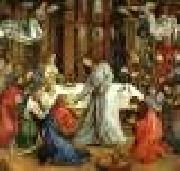 |
JOOS van Wassenhove -- Click Here
|
|
Dutch painter (active c.1460-80).
South Netherlandish painter, active also in Italy. First documented in 1460, when he matriculated in the Antwerp painters' guild, he subsequently moved to Ghent, entering the painters' guild on 6 October 1464. In 1467 he painted 40 escutcheons with the papal arms for the cathedral of St Bavo, Ghent, his only documented commission in the Netherlands. He sponsored the entry of Hugo van der Goes to the Ghent guild on 5 May 1467 and of Sanders Bening on 19 January 1469, the last date on which Joos is recorded at Ghent. He is stated, in a document of 1475, to have departed for Rome some time previously, with an advance of money from Hugo van der Goes. It is not known if Joos reached Rome, but it is generally accepted that he worked at Urbino, where early sources mention a Netherlandish painter, Giusto da Guanto (Justus of Ghent), who was responsible for the altarpiece of the Communion of the Apostles (Urbino, Pal. Ducale) of 1473-4. |
|
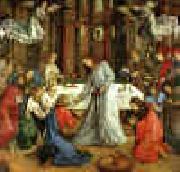 |
Joos van Ghent -- Click Here
|
|
Netherlandish Northern Renaissance Painter, active ca.1460-1480 |
|
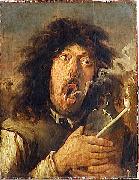 |
Joos van Craesbeeck -- Click Here
|
|
(c. 1605/06- c. 1660) was a Flemish painter who specialized in tavern interiors, tronies, and other works similar to his teacher Adriaen Brouwer. Born in Neerlinter (Flemish Brabant), he became a master in Antwerp's guild of St. Luke in 1633?C1634, and like his contemporaries David Teniers the Elder and David Rijckaert III he developed rustic genre scenes. He subsequently moved to Brussels, where he joined that city's painters' guild in 1651.
Paintings such as Death is Violent and Fast are typical of his small, theatrical images of peasants brawling crowded with violent expressive figures. Unlike Teniers, whose style became more elegant, Craesbeeck continued to paint bawdy figures later in his career.
|
|
|
|
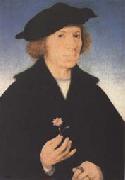 |
Joos van cleve -- Click Here
|
|
Flemish Northern Renaissance Painter, ca.1485-1540 |
|
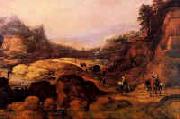 |
Joos de Momper -- Click Here
|
|
Flemish Baroque Era Painter, 1564-1635
known as Josse de Momper, is one of the most important Flemish landscape painters between Pieter Brueghel the Elder and Peter Paul Rubens. Brueghel's influence is clearly evident in this many of de Momper's paintings.
Born in 1564 in Antwerp, Joos de Momper was first apprenticed to his father. In the 1580s, he travelled to Italy to study art. De Momper primarily painted landscapes, the genre for which he was well-regarded during his lifetime. He painted both fantasy landscapes, viewed from a high vantage point and employing a conventional Mannerist color transition of brown in the foreground to blue and finally green in the background, and more realistic landscapes with a lower viewpoint and more natural colors. His wide panoramas also feature groups of figures. Only a small number of the 500 paintings attributed to De Momper are signed, and just one is dated. |
|
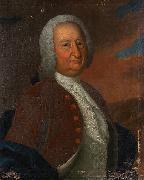 |
Jons Pilo -- Click Here
|
|
Jöns Pilo (1707-1750)Aliases: Jons O. Pijhlou; Jons O. Pijlou; Jons O. PiloProfessions: Painter
|
|
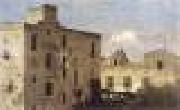 |
JONES, Thomas -- Click Here
|
|
Welsh Painter, 1742-1803 |
|
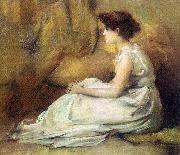 |
Jones, Francis Coates -- Click Here
|
|
American, 1857-1932 |
|
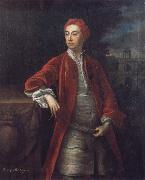 |
Jonathan Richardson -- Click Here
|
|
English Baroque Era Painter, ca.1664-1745 |
|
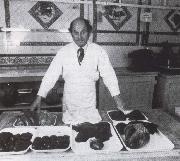 |
jonathan miller -- Click Here
|
|
(born July 21, 1934, London, Eng.) British director, writer, and actor. After earning a medical degree at Cambridge University, he made his professional stage debut at the Edinburgh Festival in the hit satirical revue Beyond the Fringe (1960). |
|
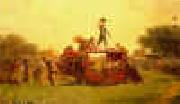 |
Jonathan Eastman Johnson -- Click Here
|
|
1824-1906
Jonathan Eastman Johnson Galleries
Eastman Johnson (July 29, 1824 - April 5, 1906) was an American painter, and Co-Founder of the Metropolitan Museum of Art, New York City, with his name inscribed at its entrance. Best known for his genre paintings, paintings of scenes from everyday life, and his portraits both of everyday people, he also painted portraits of prominent Americans such as Abraham Lincoln, Nathaniel Hawthorne, Ralph Waldo Emerson, and Henry Wadsworth Longfellow. His later works often show the influence of the 17th century Dutch masters whom he studied while living in The Hague, and he was even known as The American Rembrandt in his day.
Johnson's style is largely realistic in both subject matter and in execution. His original photorealistic charcoal sketches were not strongly influenced by period artists, but are informed more by his lithography training. Later works show influence by the 17th century Dutch and Flemish masters, and also by Jean François Millet. Echoes of Millet's The Gleaners can be seen in Johnson's The Cranberry Harvest, Island of Nantucket although the emotional tone of the work is far different.
His careful portrayal of individuals rather than stereotypes enhances the realism of his paintings. Ojibwe artist Carl Gawboy notes that the faces in the 1857 portraits of Ojibwe people by Johnson are recognizable in people in the Ojibwe community today. Some of his paintings such as Ojibwe Wigwam at Grand Portage display near photorealism long before the photorealism movement but in keeping with the American tradition of realism that can be seen in the works of Charles Willson Peale whose painting The Stairway Group is said to have fooled George Washington.
His careful attention to light sources contributes to the realism. Portraits Girl and Pets and The Boy Lincoln make use of single light sources in a manner that echoes the 17th Century Dutch Masters. |
|
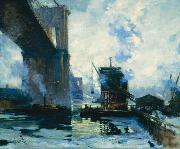 |
Jonas Lie -- Click Here
|
|
Jonas Lauritz Idemil Lie (6 November 1833 - 5 June 1908) was a Norwegian novelist, poet, and playwright who is considered to have been one of the Four Greats of 19th century Norwegian literature, together with Henrik Ibsen, Bjornstjerne Bjørnson and Alexander Kielland. |
|
|
|
 |
johnwilliam waterhouse,R.A. -- Click Here
|
|
English Pre-Raphaelite Painter, 1849-1917 |
|
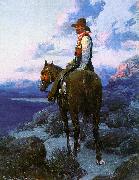 |
Johnson, Frank Tenney -- Click Here
|
|
American Painter, 1874-1939
was a painter of the american west, and he popularized a style of painting cowboys which became known as "The Johnson Moonlight Technique". Somewhere on the Range is an example of Johnson's moonlight technique. To paint his paintings he used knives, fingers and brushes. Johnson was born in Pottawattamie County, Iowa, on his family's farm along the old Overland Trail near a town then called Big Grove and now known as Oakland. Johnson's mother died in December 1886, and by 1888 the family had moved to Milwaukee. There, in 1893, he enrolled in the Milwaukee School of Art (absorbed by Milwaukee State Normal School in 1913), where he studied with a well-known painter of western subjects, Richard Lorenz. |
|
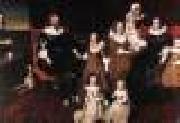 |
JOHNSON, Cornelius -- Click Here
|
|
Flemish-born English Baroque Era Painter, 1593-1661 |
|
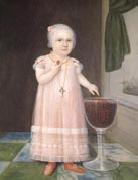 |
Johnson Joshua -- Click Here
|
|
African-American Folk Artist, ca.1763-1824 |
|
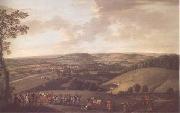 |
John Wootton -- Click Here
|
|
1682 - 1764
English painter. He probably received some instruction from Jan Wyck in the 1690s, and he was possibly patronized from an early age by the aristocratic households of Beaufort and Coventry (as was Wyck), perhaps while working as a page to Lady Anne Somerset at Snitterfield House, Warwicks. However, there seems to be no real evidence for this save his early painted view of the house and the family's later acquisition of many of his works. Joseph Farington saw a painting of Diana and the Nymphs (1707; untraced) at Antony House, Cornwall, but Wootton's earliest extant dated work is the horse portrait Bonny Black (1711; Belvoir Castle, Leics). By this time he had begun to establish himself in London, having moved there before his first marriage, to Elizabeth Walsh, in 1706. |
|
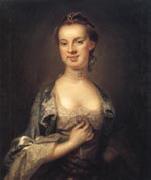 |
John Wollaston -- Click Here
|
|
English-born American Rococo Era Painter, active 1742-1775 |
|
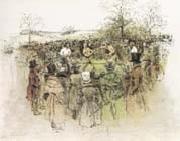 |
John Wolcott Adams -- Click Here
|
|
American Illustrator
1874-1925
|
|
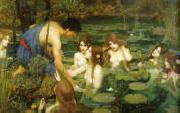 |
John William Waterhouse -- Click Here
|
|
English Pre-Raphaelite Painter, 1849-1917
English painter. His father was a minor English painter working in Rome. Waterhouse entered the Royal Academy Schools in London in 1870. He exhibited at the Society of British Artists from 1872 and at the Royal Academy from 1874. From 1877 to the 1880s he regularly travelled abroad, particularly to Italy. In the early 1870s he had produced a few uncharacteristic Orientalist keepsake paintings, but most of his works in this period are scenes from ancient history or classical genre subjects, similar to the work of Lawrence Alma-Tadema (e.g. Consulting the Oracle, c. 1882; London, Tate). However, Waterhouse consistently painted on a larger scale than Alma-Tadema. His brushwork is bolder, his sunlight casts harsher shadows and his history paintings are more dramatic. |
|
|
|
|
| | |
|
|
|
|